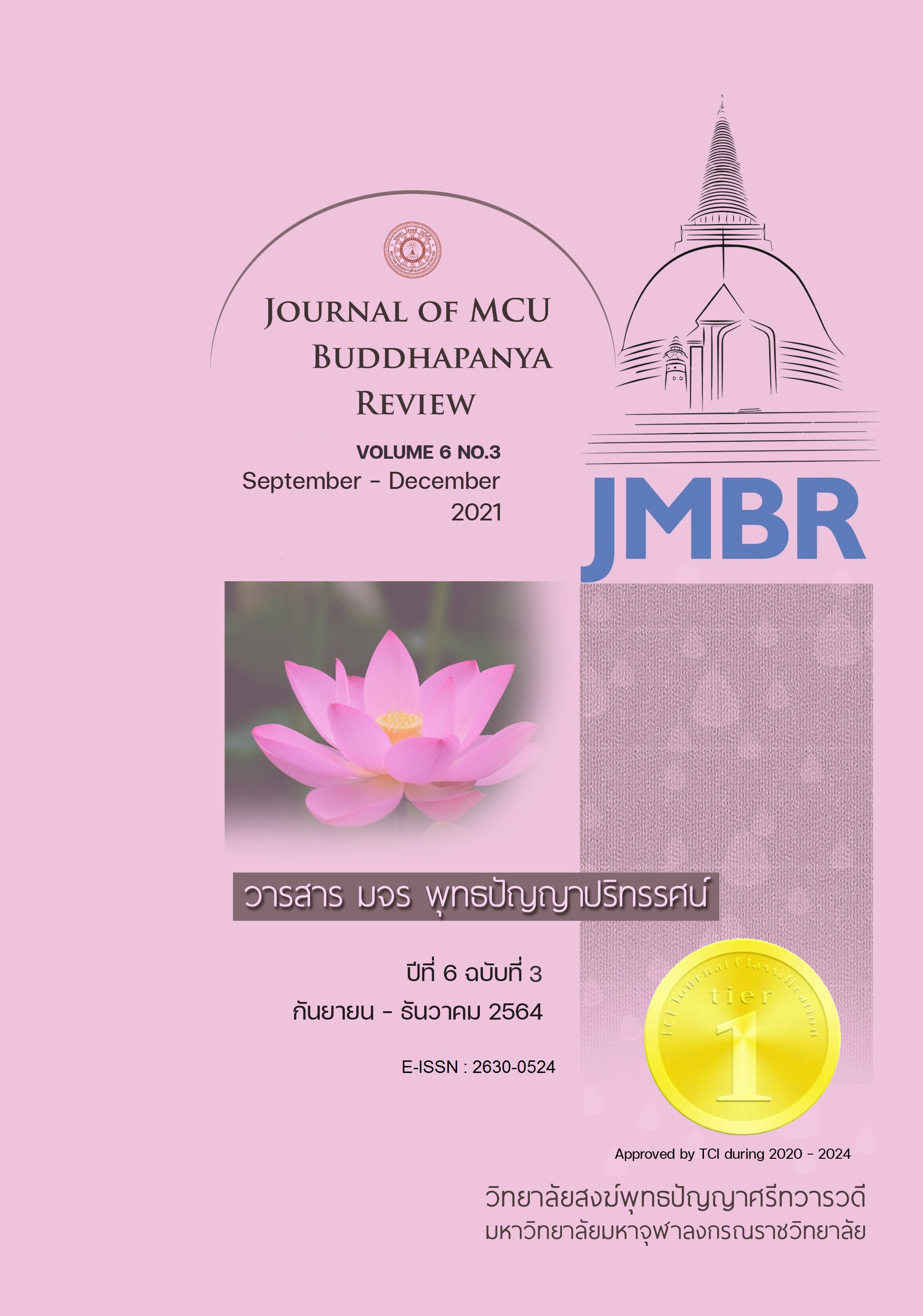การเจริญวิปัสสนากรรมฐานตามหลักสติปัฏฐาน 4 เส้นทางพ้นทุกข์
คำสำคัญ:
วิปัสสนากรรมฐาน, สติปัฏฐาน 4, เส้นทางพ้นทุกข์บทคัดย่อ
พระพุทธศาสนามีหลักคำสอนให้รู้จักทุกข์และวิธีการดับทุกข์ให้พ้นจากวัฏสังสาร คือ เกิด แก่ เจ็บ ตาย อันเป็นเหตุให้เกิดทุกข์จากกิเลสทั้งปวง คือ ความโลภ ความโกรธ ความหลง เน้นการทำความเข้าใจด้วยปัญญาและพิสูจน์ข้อเท็จจริงจนเห็นว่าทุกสรรพสิ่งเป็นไปตามกฎไตรลักษณ์ ได้แก่ อนิจจัง คือความไม่แน่นอน ทุกขังคือความไม่เที่ยงแท้ และอนัตตา คือความไม่มีตัวตน รวมทั้งสัตว์โลกย่อมเป็นไปตามกฎแห่งกรรม สอนหลักความจริงที่เป็นประโยชน์และเป็นสิ่งที่ปฏิบัติได้ในปัจจุบัน ให้ดำเนินชีวิตโดยยึดทางสายกลางอย่างมีสติเพื่อบรรลุวัตถุประสงค์อันสูงสุดคือนิพพาน โดยปรัชญาของพระพุทธศาสนามีลักษณะเป็น “สัจนิยม” หรือ “ธรรมชาตินิยม” ที่ถือว่าธรรมชาติทั้งหลายต้องเป็นไปตามหลักแห่งธรรมชาติและหลักแห่งความจริง โดยเน้นหนักที่ต้องเชื่ออย่างมีความมีเหตุผลและมีวิจารณญาณ
การเจริญวิปัสสนากรรมฐานตามหลักสติปัฏฐาน 4 เป็นการปฏิบัติธรรมโดยมีกระบวนการฝึกและพัฒนาตนเองให้รู้แจ้งเห็นจริงรู้เท่าทันธรรมชาติของชีวิต ที่มีความไม่เที่ยงและบังคับไม่ได้ อันเป็นสาเหตุของการเกิดทุกข์ ผู้ที่นำมาปฏิบัติอย่างสม่ำเสมอและถูกต้องจะทำให้เกิดปัญญา เกิดความรู้ ความเข้าใจในรูป-นามตามความเป็นจริง รู้แจ้งในกฎไตรลักษณ์ คือ อนิจจัง ทุกขัง อนัตตา มีความมั่นคงทางอารมณ์และมีภูมิคุ้มกันทางจิต ช่วยเสริมสุขภาพกาย และสามารถพัฒนาสติปัญญาเพื่อการดำเนินชีวิตได้อย่างถูกต้องและนำไปสู่การขจัดกิเลส เพื่อการบรรลุมรรค ผล นิพพาน อันเป็นเป็นเส้นทางแห่งการพ้นทุกข์ได้ในที่สุด
เอกสารอ้างอิง
ภัทรนิธิ์ วิสุทธิศักดิ์. (2552). รูปแบบผลมผลานการปฏิบัติวิปัสสนากรรมฐานตามหลักสติปัฏฐาน. วิทยานิพนธ์พุทธศาสตรดุษฎีบัณฑิต สาขาวิชาพระพุทธศาสนา มหาวิทยาลัยมหาจุฬาลงกรณ์ราชวิทยาลัย.
พระครูสุนทรกาญจนาคม (แก้วเกิด สุพฺพจฺโจ). (2559). “ศึกษาแนวทางการปฏิบัติวิปัสสนาภาวนาใน
สติสัมปชัญญสูตร”. วิทยานิพนธ์พุทธศาสตรมหาบัณฑิต สาขาวิชาวิปัสสนาภาวนา. มหาวิทยาลัยมหาจุฬาลงกรณราชวิทยาลัย.
พระพรหมคุณาภรณ์ (ป.อ. ปยุตโต). (2553). รู้หลักก่อนแล้วศึกษาและสอนให้ได้ผล. กรุงเทพมหานคร:
พิมพ์สวย.
. . (2557). พุทธธรรม ฉบับปรับขยาย. พิมพ์ครั้งที่ 39. กรุงเทพมหานคร: โรงพิมพ์มหาจุฬาลงกรณราชวิทยาลัย.
พระธรรมปิฎก (ป.อ. ปยุตโต). (2538). พจนานกรมพุทธศาสน์ ฉบับประมวลศัพท์. กรุงเทพมหานคร: โรงพิมพ์มหาจุฬาลงกรณราชวิทยาลัย.
. . (2546). โพธิปักขิยธรรม 37 ประการ. กรุงเทพมหานคร: โรงพิมพ์มหาจุฬาลงกรณราชวิทยาลัย.
พระธรรมธีรราชมหามุนี (โชดก ญาณสิทฺธิ ป.ธ.9). (2532). วิปัสสนากรรมฐาน. กรุงเทพมหานคร: ทอมรินทร์พริ้นติ้งกรุ๊พ จำกัด.
พระโสภณมหาเถระ (มหาสีสยาดอ). (2549). มหาสติปัฏฐานสูตร ทางสู่พระนิพพาน. แปลโดย พระคันธ
สาราภิวงศ์. กรุงเทพมหานคร: ไทยรายวันการพิมพ์.
มหาจุฬาลงกรณราชวิทยาลัย. (2539). พระไตรปิฎกภาษาไทย ฉบับมหาจุฬาลงกรณราชวิทยาลัย. กรุงเทพมหานคร: โรงพิมพ์มหาจุลงกรณราชวิทยาลัย.
สมเด็จพระพุฒาจารย์ (อาจ อาสภมหาเถร). (2548). วิสุทธิมรรค. กรุงเทพมหานคร: ธนาเพรส
VEN. PHRA SOPHY PHAV RATANAJOTO. (2562). “ศึกษาวิเคราะห์ปรมัตถภาวนาตามหลักสติปัฏฐาน 4: กรณีศึกษาการปฏิบัติปรมัตถภาวนาของวัดมเหยงคณ์ อำเภอพระนครศรีอยุธยาจังหวัดพระนครศรีอยุธยา” พุทธศาสตรมหาบัณฑิต สาขาวิชาพระไตรปิฎกศึกษา. มหาวิทยาลัยมหาจุฬาลงกรณราชวิทยาลัย.



